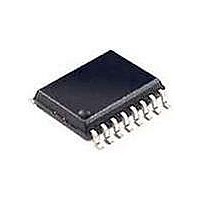SI3050-KT Silicon Laboratories Inc, SI3050-KT Datasheet - Page 33

SI3050-KT
Manufacturer Part Number
SI3050-KT
Description
IC VOICE DAA GCI/PCM/SPI 20TSSOP
Manufacturer
Silicon Laboratories Inc
Type
Chipsetr
Specifications of SI3050-KT
Package / Case
20-TSSOP
Function
Data Access Arrangement (DAA)
Interface
PCM, Serial, SPI
Number Of Circuits
1
Voltage - Supply
3 V ~ 3.6 V
Current - Supply
8.5mA
Operating Temperature
0°C ~ 70°C
Mounting Type
Surface Mount
Includes
Line Voltage Monitor, Loop Current Monitor, Overload Detection, Parallel Handset Detection, Polarity Reversal Detection, TIP and
Product
Modem Chip
Supply Voltage (min)
3 V
Supply Current
8.5 mA
Maximum Operating Temperature
+ 70 C
Minimum Operating Temperature
0 C
Mounting Style
SMD/SMT
Lead Free Status / RoHS Status
Contains lead / RoHS non-compliant
Power (watts)
-
Lead Free Status / RoHS Status
Lead free / RoHS Compliant, Contains lead / RoHS non-compliant
Available stocks
Company
Part Number
Manufacturer
Quantity
Price
Part Number:
SI3050-KT
Manufacturer:
SILICONIX
Quantity:
20 000
Company:
Part Number:
SI3050-KTR
Manufacturer:
NEC
Quantity:
947
Part Number:
SI3050-KTR
Manufacturer:
SILICON LABS/芯科
Quantity:
20 000
Billing Tone Filter (Optional)
To operate without degradation during billing tones in
Germany, Switzerland, and South Africa, an external LC
notch filter is required. The Si3018/19 can remain
off-hook during a billing tone event, but line data is lost
in the presence of large billing tone signals. The notch
filter design requires two notches, one at 12 kHz and
one at 16 kHz. Because these components are
expensive and few countries utilize billing tones, this
filter is typically placed in an external dongle or added
as a population option. Figure 23 shows a billing tone
filter example. Table 19 gives the component values.
L1 must carry the entire loop current. The series
resistance of the inductors is important to achieve a
narrow and deep notch. This design has more than
25 dB of attenuation at both 12 kHz and 16 kHz.
The billing tone filter affects the DAA’s ac termination
and return loss. The global compromise complex ac
termination as selected by ACIM[3:0] = 1111 passes
global return loss specifications with and without the
billing tone filter by at least 3 dB. This ac termination is
optimized
cancellation and has greater than 4 dB of margin with or
without the dongle for South Africa, Australia, TBR21,
Table 19. Component Values—Optional Billing
Component
From Line
RING
C1,C2
TIP
C3
L1
L2
Figure 23. Billing Tone Filter
for
frequency
3.3 mH, >120 mA, <10 Ω , ±10%
10 mH, >40 mA, <10 Ω , ±10%
Tone Filters
0.027 µ F, 50 V, ±10%
0.01 µ F, 250 V, ±10%
C1
C2
L1
response
Value
C3
L2
DAA
To
and
hybrid
Rev. 1.0
Germany,
specifications.
On-Hook Line Monitor
The Si3050 allows the user to receive line activity when
in an on-hook state. This mode is typically used to
detect caller ID data (see the “Caller ID” section) and is
enabled by setting the ONHM bit (Register 5, bit 3).
Caller ID data can be gained up or attenuated using the
receive gain control bits in Registers 39 and 41.
Caller ID
The Si3050 can pass caller ID data from the phone line
to a caller ID decoder connected to the DAA.
Type I Caller ID
Type I Caller ID sends the CID data when the phone is
on-hook.
In systems where the caller ID data is passed on the
phone line between the first and second rings, utilize the
following method to capture the caller ID data:
1. After identifying a ring signal using one of the methods
2. Assert the ONHM bit (Register 5
3. Clear the ONHM bit after the caller ID data is received.
In systems where the caller ID data is preceded by a
line polarity (battery) reversal, use the following method
to capture the caller ID data:
1. Enable full wave rectified ring detection (RFWE,
2. Monitor the RDTP and RDTN register bits (or the POLI bit
3. Assert the ONHM bit (Register 5
4. Clear the ONHM bit after the caller ID data is received.
Type II Caller ID (Si3019 Line-Side Device Only)
Type II Caller ID sends the CID data while the phone is
off-hook. This mode is often referred to as caller ID/
call waiting (CID/CW). To receive the CID data when
described in "Ring Detection" on page 30, determine when
the first ring is complete.
data detection. The caller ID data is passed across the
RNG 1/2 pins and presented to the host via the DTX pin.
Register 18
with the Si3019 line-side) to identify if a polarity reversal or
a ring signal has occurred. A polarity reversal trips either
the RDTP or RDTN ring detection bits, therefore the
full-wave ring detector must be used to distinguish a
polarity reversal from a ring. The lowest specified ring
frequency is 15 Hz; so, if a battery reversal occurs, the
DSP should wait a minimum of 40 m
event is a battery reversal and not a ring signal. This time
is greater than half the period of the longest ring signal. If
another edge is detected during this 40 m
event is characterized as a ring signal and not a battery
reversal.
data detection. The caller ID data is passed across the
RNG 1/2 pins and presented to the host via the DTX pin.
, bit
and
1).
Switzerland
, bit
, bit
s
3) to enable caller ID
3) to enable caller ID
to verify that the
country-specific
Si3050
s
pause, this
33












